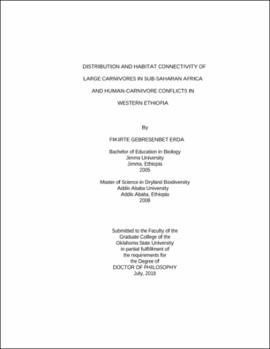| dc.contributor.advisor | Papeş, Monica | |
| dc.contributor.author | Erda, Fikirte Gebresenbet | |
| dc.date.accessioned | 2023-09-20T22:17:37Z | |
| dc.date.available | 2023-09-20T22:17:37Z | |
| dc.date.issued | 2018-07 | |
| dc.identifier.uri | https://hdl.handle.net/11244/339593 | |
| dc.description.abstract | Large carnivores are threatened with habitat fragmentation, prey depletion, and human-carnivore conflicts. Africa has an intact guild of large carnivores but data on their distribution and status are scare. Since large carnivores exist in low densities across large home ranges, traditional mammal survey techniques are impractical. I used a predictive modeling approach to estimate the potential distribution and connectivity between suitable patches for African wild dog (Lycaon pictus), cheetah (Acinonyx jubatus), leopard (Panthera pardus), and lion (P. leo) across sub-Saharan Africa. Ecological niche modeling in Maxent algorithm generated potential distributions of the four carnivores by identifying environmentally suitable conditions. All Maxent models had good predictive capabilities (AUC > 0.80, and testing omission error <0.01). Removing unsuitable land cover types and high human population density from the Maxent outputs maintained majority (>88%) of the Maxent prediction. African wild dogs had the most fragmented and isolated patches, while leopards had the most intact patches. Western and central Africa appeared more fragmented, which might have been the natural state of these regions. Least-cost connectivity analysis identified 747 corridors, which could be prioritized based on different criteria. To investigate human-carnivore conflicts, I designed two local scale studies in Kafa Biosphere Reserve (KBR) and Gambella National Park (GNP), in western Ethiopia. Attitudes of local people were assessed towards lions and leopards in KBR and towards lions in GNP. Data were collected using household surveys (KBR and GNP), focus group discussions (KBR only), key informant interviews, and opportunistic informal discussions (GNP only). In Kafa, lions cause more economic damage than leopards, but lions are tolerated because they are respected in the Kafa culture. Although leopards are not given the same respect as lions, they also do not face indiscriminate killing in KBR. The data from GNP revealed that theft and disease are the leading causes of livestock loss, although respondents blame lions to be the main cause of depredation. Economic loss by lions is higher in Kafa than Gambella, but the culture of tolerance in KBR allows for the survival of lions. Participatory conservation approach, guided by Arnstein’s ladder of participation, might foster tolerance in GNP. | |
| dc.format | application/pdf | |
| dc.language | en_US | |
| dc.rights | Copyright is held by the author who has granted the Oklahoma State University Library the non-exclusive right to share this material in its institutional repository. Contact Digital Library Services at lib-dls@okstate.edu or 405-744-9161 for the permission policy on the use, reproduction or distribution of this material. | |
| dc.title | Distribution and habitat connectivity of large carnivores in Sub-Saharan Africa and human-carnivore conflicts in Western Ethiopia | |
| dc.contributor.committeeMember | McBee, Karen | |
| dc.contributor.committeeMember | Vadjunec, Jacqueline M. | |
| dc.contributor.committeeMember | O'Connell, Tim | |
| osu.filename | Erda_okstate_0664D_15902.pdf | |
| osu.accesstype | Open Access | |
| dc.type.genre | Dissertation | |
| dc.type.material | Text | |
| dc.subject.keywords | distribution and connectivity | |
| dc.subject.keywords | Gambella | |
| dc.subject.keywords | human-carnivore conflict | |
| dc.subject.keywords | KAFA | |
| dc.subject.keywords | large carnivores | |
| dc.subject.keywords | Sub-Saharan Africa | |
| thesis.degree.discipline | Zoology | |
| thesis.degree.grantor | Oklahoma State University | |
